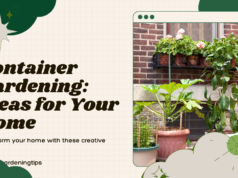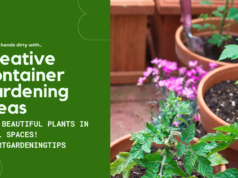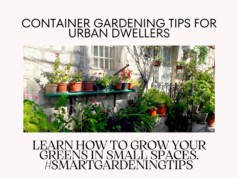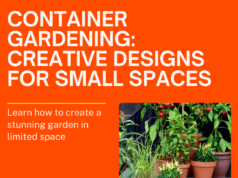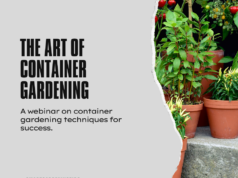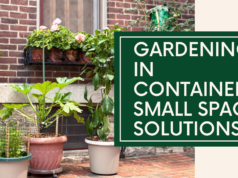Welcome to the world of container gardening, where the possibilities are endless and the beauty is unbounded. Whether you have a tiny balcony or a spacious patio, container gardening offers a world of potential for creating an aesthetically appealing outdoor space. By combining plants and design elements, you can create a stunning display that reflects your personal style and enhances the overall ambiance of your outdoor area. In this section, we will explore the art of container garden design, and provide you with tips and ideas to create an outdoor space that is both visually beautiful and functional.
Key Takeaways:
- Container gardening offers endless possibilities for adding beauty and charm to your surroundings.
- With the right containers, plant selection, and design techniques, you can create a stunning container garden.
- Proper care and maintenance are crucial for ensuring the health and longevity of your container garden.
- Container gardens offer versatility and flexibility, allowing you to change and rearrange your arrangement to match your personal style.
- Incorporating trees and shrubs in containers can create a sense of height and drama in your outdoor space.
Choosing the Right Containers for Your Garden
If you’re looking for garden ideas to inspire your patio, garden, or small outdoor space, container gardening is a great place to start. Container gardens allow for flexibility, offering planting ideas that can fit any style and space. Choosing the right containers is the first step to creating a stunning container garden that complements your outdoor space.
Consider the following before selecting your containers:
- The size of your outdoor space
- The type of garden you want to create (herb garden, succulent garden, vegetable garden, water garden, etc.)
- The amount of sunlight your outdoor space receives
- The types of plants you want to grow
There are various types of containers to choose from, including:
| Pot | Planter | Urn |
|---|---|---|
| Traditional pot with drainage holes at the bottom. Ideal for small spaces like a patio or balcony. | Larger planter box with a flat bottom and deep sides. Provides more space for planting and can be placed on the ground. | Decorative urn-shaped container with a wide base and narrow opening. Great for creating a focal point in your garden. |
When selecting your containers, it’s essential to consider their material, drainage, and weight. Terracotta pots are a popular option for their natural, rustic look and excellent drainage. However, they can be heavy and dry out quickly, requiring more frequent watering. Plastic containers are lightweight, durable, and retain moisture well. They are also an affordable option for those on a budget. Ceramic containers provide a wide range of decorative options but are prone to cracking and may require careful handling.
For a cohesive garden design, consider using containers of similar size and style. Grouping containers together can create a visually appealing display, adding height and depth to your garden. Also, keep in mind that your containers will need to fit the plants you want to grow. Larger plants will need more substantial containers to provide adequate room for growth.
Overall, your container choice should depend on your garden space, the look you want to achieve and the plants you want to grow. Whichever type of container you choose, ensure it is suitable for the plants you intend to cultivate and complements your garden decor.
Plant Selection and Combination for Stunning Containers
The beauty of container gardening lies not only in the containers themselves, but also in the plants selected for them. With endless varieties of plants to choose from, you can create a stunning container garden by selecting the right plants and combining them harmoniously. Here are some suggestions for plants that work well in various types of containers:
Succulents
Succulents are a popular choice for container gardens due to their low maintenance requirements and ability to thrive in various growing conditions. They come in a range of colors, shapes, and sizes, making them ideal for creating visually appealing containers. Try combining different succulent varieties in a shallow dish or bowl for a beautiful container garden.
Pot Plants
Pot plants are another versatile option for container gardens, as they can be easily moved around and planted in a range of container types. Some popular pot plants include petunias, marigolds, and geraniums, which come in a variety of colors and can be used to create vibrant displays. Make sure to choose plants that have similar sunlight and water requirements.
Foliage
Foliage plants are a great option for adding texture and visual interest to your container garden. Some popular foliage plants include ferns, hostas, and ornamental grasses, which come in a range of colors and textures. Try combining different foliage varieties in a large container to create a beautiful container garden.
Herb Garden
An herb garden in containers is not only functional, but also beautiful. Herbs such as rosemary, thyme, and parsley not only provide fresh ingredients for your cooking, but also add a fragrant aroma to your outdoor space. Try planting a variety of herbs in a large container and placing it near your kitchen for easy access.
Succulent Garden
A succulent garden is a beautiful and low-maintenance option for container gardening. Combine different succulent varieties in a shallow dish or bowl for a stunning display. Make sure to use a well-draining soil mix and water sparingly.
Vegetable Garden
Container gardening also offers the opportunity to grow your own vegetables, even in limited spaces. Consider planting tomatoes, peppers, and lettuce in large containers for a bountiful vegetable garden. Make sure to use a high-quality potting mix and provide adequate water and sunlight.
Water Garden
For a unique and serene container garden, try creating a water garden in a large container. Use water-loving plants such as water lilies and lotuses, and add decorative features such as rocks and statues to create a focal point. Make sure to provide adequate drainage and change the water regularly.
No matter what type of plants you choose for your container garden, it’s important to create a focal point. A focal point can be a single plant or a combination of plants that captures the eye and adds visual interest to your container garden. To create a focal point, consider using a tall or trailing plant in the center of your container, surrounded by shorter plants that complement it.
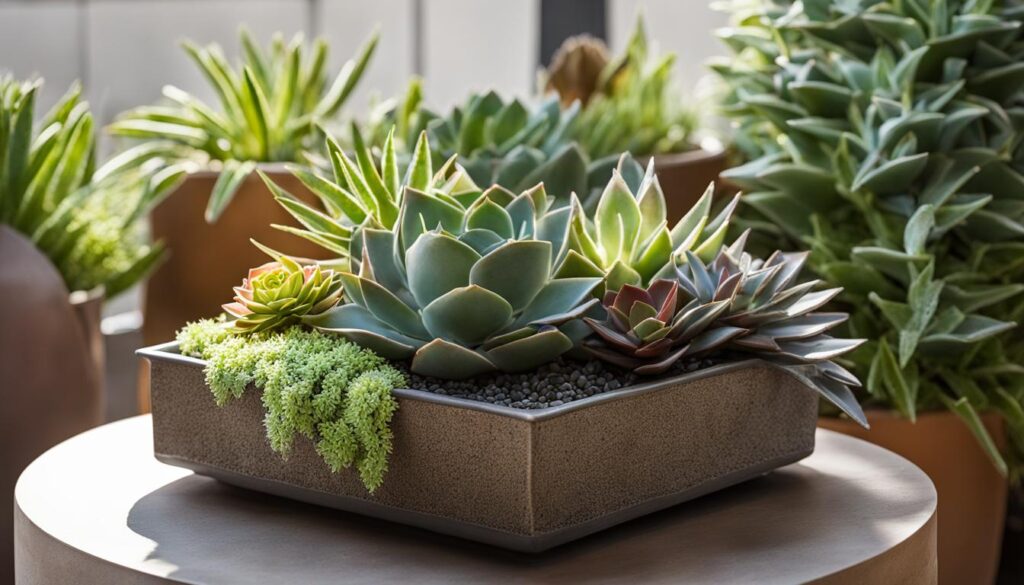
Container Design Techniques for Visual Interest
Designing beautiful containers requires an eye for detail and the right techniques. Here are some insights to create visual interest with your containers:
Color Combinations
Color is one of the most critical components of container design. When selecting colors, consider the surrounding environment and note the existing color scheme. For instance, if you have a brightly colored wall, opt for neutral-colored containers that won’t compete visually. When choosing plants, use a color wheel to find complementary or analogous shades that work well together. For example, a petunia’s vibrant purple pairs well with a yellow rosemary shrub in a window box.
Textures and Varying Plant Heights
Texture plays an essential role in container design, creating visual interest by adding depth and dimension. Combining plants with different textures can create a dramatic visual effect. For example, pairing ornamental grasses with parsley or rosemary can enhance their soft and feathery texture. Varying plant heights, such as combining trailing plants with upright plants in hanging baskets, creates a natural flow and adds interest.
Proven Winners
Proven Winners are plants that are rigorously tested and selected for their performance and unique attributes. Incorporating these plants into container design ensures not only their beauty but also their ability to thrive and perform well. Examples of such plants are the petunia, which comes in various colors and sizes, and the ornamental pepper, known for its bright and colorful foliage.
Using these container design techniques, you can take your container garden to the next level, enhancing its visual intrigue and aesthetic appeal.
Tips for Proper Container Care and Maintenance
Container gardening is an excellent way to bring some greenery into your outdoor space, whether you have a large container or small. It’s essential to take proper care of your containers to keep them looking beautiful and healthy. Here are some tips for maintaining your garden:
Choosing the Right Container
When selecting the right container, it’s important to consider the size of your plants and their root systems. Large containers work best for plants with larger root systems and provide ample space for growth. Small containers are suitable for smaller plants and are ideal for those with limited space.
Remember to select containers that are good for your garden features, kitchen garden or planter ideas, and low maintenance. Garden planters come in a variety of materials, including terracotta, plastic, and metal. Choose the material that’s best for your garden’s specific needs.
Watering
Watering is crucial for the health of your plants. Ensure that your containers have adequate drainage so that water doesn’t pool at the bottom, which can result in root rot. Avoid watering your plants too much or too little and check the soil regularly to see if it’s dry. It’s best to water your containers in the morning or evening when the temperature is cooler.
Choosing the Right Potting Mix
Choose the right potting mix for your plants, as it provides essential nutrients and drainage. Look for high-quality potting mix composed of a blend of peat moss, vermiculite, and perlite. Avoid using soil from your garden as it is too dense for container plants and may contain pests or diseases that could affect your plants.
Low Maintenance Options
If you have a busy lifestyle, choose low maintenance plants, such as succulents, herbs, and some tropical plants like snake plants and ZZ plants. These plants require less frequent watering and can tolerate a range of temperatures and light levels. Edible gardens, such as vegetable gardens or herbs, are also an excellent low maintenance option for your containers.
Best Plants for Pots
The best plants for pots depend on your preferences and the conditions of your garden. Some popular options include geraniums, petunias, rosemary, parsley, and sweet potato vine. Consider adding colorful foliage to your containers to enhance their visual appeal.
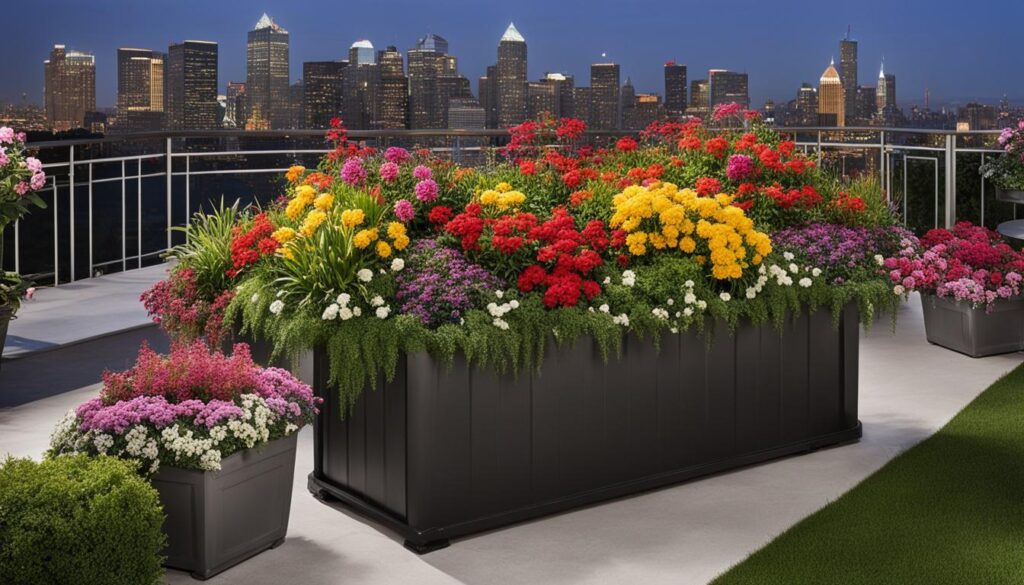
These tips for proper container care and maintenance will ensure that your container garden thrives and adds beauty to your outdoor space. By selecting the right container and plants, watering properly, and using the right potting mix, your garden will be healthy and beautiful for years to come.
Creating a Focal Point with Container Gardens
Container gardening is a great way to add charm and beauty to your outdoor space, and creating a focal point with container gardens is a great way to make a statement. Whether you want to add a pop of color, texture, or height to your garden design, container gardens offer the versatility to create a captivating focal point. Here are some tips on how to design containers that become focal points:
Choose the Right Type of Plant
The key to creating a captivating focal point with container gardens is to select the right plants as fillers, spillers, and thrillers. The filler plants are the ones that create the bulk of the container, spillers are the ones that trail over the edge of the container, and thrillers are the plants that create height and drama. When selecting the plants for your containers, consider the color, texture, and overall design of your garden space.
Ensure Proper Drainage
Proper drainage is essential to the health and longevity of your container garden. Without adequate drainage, your plants may suffer from root rot or become waterlogged. Be sure to select containers with drainage holes, and use a well-draining potting mix to help prevent water from pooling in the container.
Use a Potting Mix
The type of potting mix you use can make a big difference in the health of your plants. Avoid using garden soil in your containers, as it can become compacted and limit airflow to the roots. Instead, use a potting mix specifically designed for containers, which will provide the proper nutrients and drainage for your plants.
Choose Fillers, Spillers, and Thrillers
Filler plants are often used as the base of the container, providing bulk and volume. Spiller plants trail over the edge of the container, softening the edges and adding a touch of whimsy. Thriller plants create height and drama, drawing the eye to the center of the container. Choose plants that complement each other in color and texture to create a harmonious design.
Design a Container That Works for You
Designing a container that works for you is an essential aspect of creating a captivating focal point. Consider the size, shape, and style of the container, and how it will fit into your overall garden design. Whether you want a modern, minimalist look or a more traditional feel, there are container options to suit your style.
Conclusion
Creating a focal point with container gardens is a fun and creative way to enhance the aesthetic appeal of your outdoor space. By selecting the right type of plant, ensuring proper drainage, using a potting mix, choosing fillers, spillers, and thrillers, and designing a container that works for you, you can create a captivating focal point that will catch everyone’s eye. Have fun and get creative with your container garden design!
Tips for Creating Cohesion with Container Groupings
Container gardening offers endless possibilities for creating beautiful and cohesive outdoor spaces. Grouping containers together is an excellent way to add visual appeal and create a cohesive garden display. Here are some tips and ideas for creating container groupings that incorporate a combination of plants, textures, and colors.
Container Ideas
Choosing the right garden pots is crucial for creating beautiful container groupings. Consider using different sizes and styles of containers to add interest and depth to your arrangement. You can use large garden containers as focal points and smaller pots to fill in gaps or add height to your design.
Combination of Plants
When selecting plants for your container garden recipes, choose a variety of plants that complement each other in terms of color, texture, and growth habit. Consider using a mix of colorful flowers, trailing plants like sweet potato vine, and ornamental foliage plants. You can also incorporate herbs or vegetables for added interest and functionality.
Trailing Plants
Trailing plants like trailing petunias or sweet potato vine are excellent for adding a cascading effect to your container garden. Use them to fill in gaps or drape over the sides of your containers. They add a beautiful touch of color and texture to your garden and can soften the edges of your container groupings.
Garden Container
Using a garden container as the centerpiece of your container grouping is an excellent way to create a focal point. Consider using a large pot or urn as the central container and surround it with smaller pots or planters. You can also use a garden container to create a vertical garden or living wall by planting a variety of plants in different pockets or tiers.
| Plant Type | Height | Color | Texture |
|---|---|---|---|
| Petunias | 6-12 inches | Pink, Purple, White | Smooth |
| Sweet Potato Vine | 12-18 inches | Green, Purple, Black | Textured (heart-shaped leaves) |
| Geraniums | 12-24 inches | Red, Pink, White | Smooth |
| Marigolds | 6-12 inches | Orange, Yellow | Smooth |
Table: Sample Plants for Container Groupings.
Colorful Flowers
Colorful flowers are a great way to add visual interest to your container groupings. Consider using a mix of annuals and perennials in different colors and textures. You can also experiment with color combinations to create a bold and eye-catching display.
Conclusion
Creating a cohesive container garden grouping is all about choosing the right containers, plants, and colors to complement each other. Whether you’re using garden pots or unique planters, incorporating trailing plants or colorful flowers, or creating a vertical garden, there are endless possibilities for creating a stunning container garden display. With these tips and ideas, you can take your container gardening to the next level and enjoy a beautiful outdoor space.
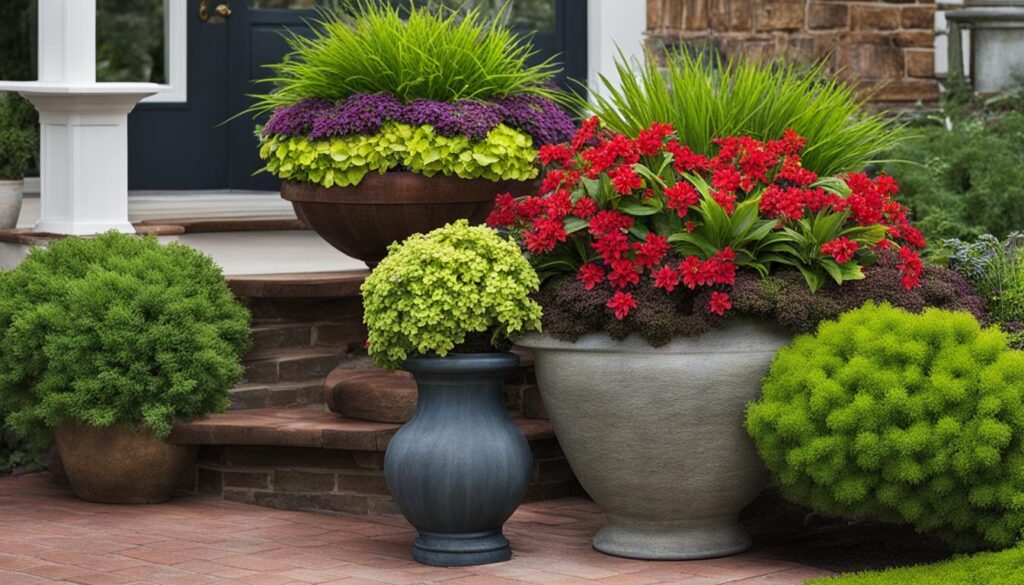
Maximizing Small Spaces with Container Gardens
Even if you have limited outdoor space, you can still enjoy the beauty of container gardens. In fact, small containers and large pots are perfect for creating a lush garden in a small area. To maximize the impact of your container garden, consider placing your containers at eye level. This draws the eye upwards and creates the illusion of a larger space.
If you have a small balcony, porch, or patio, container gardens are an easy way to add greenery and color to your space. Consider using colorful foliage plants, such as sweet potato vine, to brighten up your area.
Low-maintenance container gardening options are ideal for those with busy lifestyles. Choose plants that don’t require frequent watering or maintenance, such as succulents or trailing plants, and pair them with a simple, yet beautiful container. This will ensure a visually appealing garden with minimal effort.
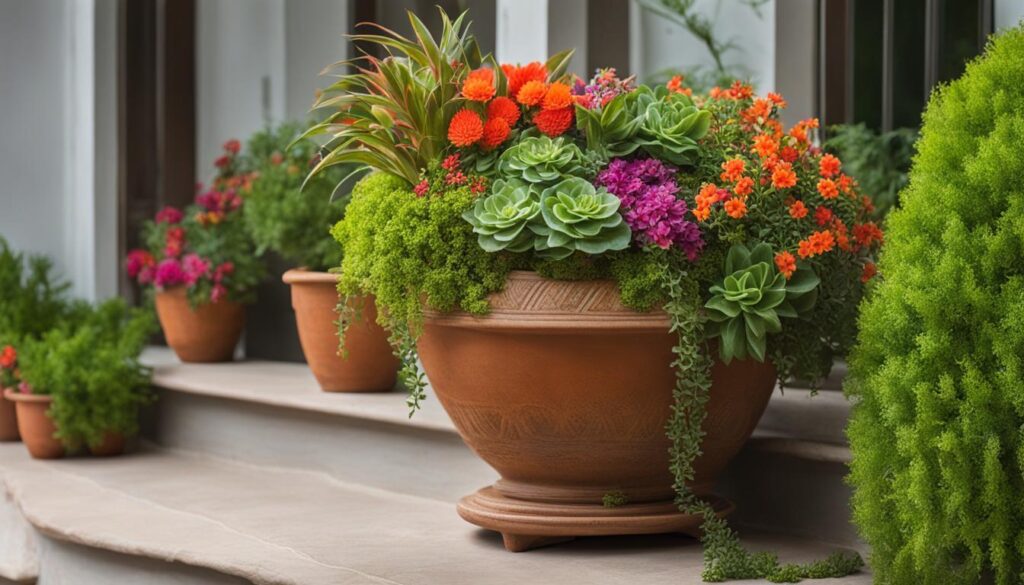
Don’t be afraid to spread your container garden around the garden. Placing pots around the garden adds interest and color to a variety of areas. Consider placing a small container on a decorative stool or stand to create a unique feature.
The Benefits of Container Gardening
Are you tired of the tedious work that goes into maintaining a traditional garden? Keep it simple with container gardening! By planting plants in containers, you can create a beautiful garden that is easy to care for and maintain.
The ability to container garden and create without having to worry about tilling and maintaining traditional garden beds is a huge advantage. Additionally, container gardens offer local garden enthusiasts a way to grow plants in any outdoor space. You can source everything you need, including garden centers, plants, containers, and quality garden soil from local retailers, making it easy to get started with container gardening.
Low-maintenance container gardening is perfect for those with busy lifestyles who still want to enjoy the beauty of gardening. Container gardens require little watering and weeding, and you can position them in any outdoor space that receives enough sunlight. With minimal effort, you can create a stunning display of colorful foliage and plants in containers that will add visual appeal to your outdoor living space.
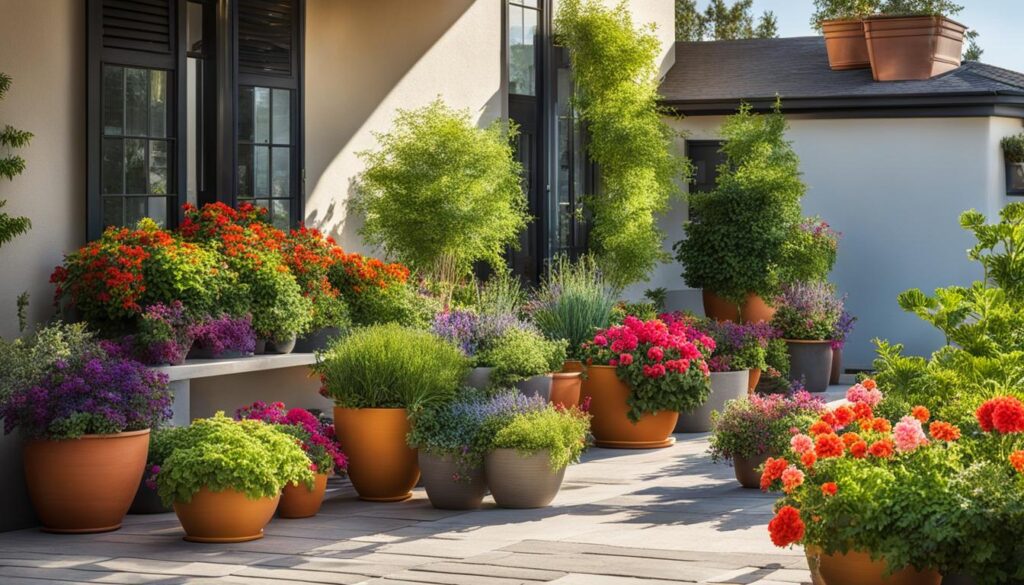
Another significant benefit of container gardening is the ability to move the pots around and create different garden arrangements. Whether you have a porch or patio with limited space or a large outdoor garden area, container gardening allows you to utilize space wisely and creatively. You can also use container gardens to create a living wall, place pots around the garden, or add focal points to your outdoor space.
Essential Tips for Successful Container Gardening
Container gardening is a great way to add some greenery to your porch or patio, regardless of its size. To ensure your plants thrive, make sure to water regularly to keep the soil moist, especially during hot and dry periods.
For small spaces, consider a living wall or pots around your garden to make the most of your available space. Adding colorful foliage can also bring visual interest to your containers.
When choosing a sunny spot to place your containers, make sure to plant in an area that receives at least six hours of sunlight per day. This will help your plants grow and thrive.
If you’re considering creating a living wall, make sure to choose low-maintenance plants that can withstand the conditions. You can also use a drip irrigation system to ensure your plants receive the necessary water they need.
Pots around your garden are an excellent way to add visual interest to your outdoor space. Consider using different sizes and shapes, and fill them with contrasting colors and textures.
Container gardening is a low-maintenance way to add greenery to your outdoor space, and it’s a great option even if you have a busy lifestyle. With some regular care and attention, your container garden will thrive and bring beauty and charm to your surroundings.
Thriving Plants in Containers: Sun or Shade Conditions
Choosing the right plants for your container garden can be challenging, especially when it comes to ensuring they thrive in the right conditions. Whether you have a sunny patio or a shaded garden, there are small plants that can flourish in terra-cotta pots and add visual appeal to your outdoor space.
Foliage plants are a great option for containers in both sun or shade conditions. Some popular choices include ferns, hostas, and heucheras, which come in a variety of colors and textures.
When choosing plants for sunny containers, make sure they thrive in full sun conditions. Some excellent options include petunias, marigolds, and roses. For shaded containers, consider plants such as impatiens, begonias, and sweet potato vine, which thrive in partial to full shade conditions.
Remember to choose appropriate size and style terra-cotta pots for your plants and ensure they have adequate drainage so that they can thrive in their container environment. With the right plants and proper care, your container garden can become a stunning and flourishing addition to your outdoor space.
Incorporating Trees and Shrubs in Containers
Adding small trees and shrubs to your container garden can create a dramatic sense of height and a focal point. As with any container garden, choosing the right container is essential. Containers of similar size and style work well when grouping trees and shrubs together. Placing them in a sunny spot near your kitchen or outdoor seating area keeps them within view and adds to the overall aesthetic appeal.
The best way to plant trees and shrubs in containers is to plant them directly in the container. This ensures that they have adequate drainage and enough space for their roots to grow. When planting, place the plants in the center of the container to create the focal point, with other plants arranged around them to complement their size and shape.
| Small Trees | Shrubs |
|---|---|
| Japanese Maples | Rosemary |
| Flowering Dogwood | Boxwood |
| Crepe Myrtle | Hydrangea |
When planting trees and shrubs in containers, it’s important to ensure that they receive adequate water and nutrients. Water regularly and make sure the container has adequate drainage. You can also add slow-release fertilizer to the potting mix to provide the plants with necessary nutrients.
Incorporating small trees and shrubs in your container garden adds a new level of height and interest. Using containers of similar size and style, placing them in a sunny spot, and planting them directly in the pot ensures they thrive. By selecting the right plant combinations, you can create a stunning focal point in your garden.
Versatility and Flexibility: Changing Container Arrangements
One of the most significant advantages of container gardening is the ability to change and rearrange your container arrangements quickly. Whether you want to refresh your garden’s look or adapt to different weather conditions, moving your pots around can add versatility and flexibility to your outdoor space.
Unlike traditional garden beds that remain static, container gardens can quickly shift from one location to another, allowing you to experiment with different layouts and configurations. You can move your containers to change the focal point of your garden, create new pathways, or add visual interest to areas that were previously overlooked.
Another benefit of changing your container arrangements is that it can extend the longevity of your plants. Over time, plants can outgrow their containers or experience changes in light or temperature conditions. By moving your pots around, you can help your plants adapt to new environments and thrive for up to three years or longer.
So don’t be afraid to get creative and experiment with different container arrangements. You might discover new design possibilities that you never thought were possible before. Remember, container gardening is all about flexibility, versatility, and creativity.
Conclusion
Congratulations, you have now gained a deeper understanding of the art of container garden design and are equipped with tips and ideas to create an aesthetically appealing outdoor space. Remember, selecting the right containers, plants, and design techniques are crucial for a successful container garden. Proper care and maintenance, maximizing small spaces, and creating stunning focal points are essential aspects to improve the health and longevity of your garden.
Incorporating trees and shrubs, changing container arrangements, and exploring the versatility and creativity of container gardening are just a few ways to enhance the aesthetic appeal of your outdoor space. You now have the knowledge to create a visually stunning and functional container garden that will bring beauty and charm to your surroundings.
Embrace the versatility and creativity of container gardening to transform your patio, garden, or any outdoor area into a beautiful and peaceful oasis. Happy planting!


